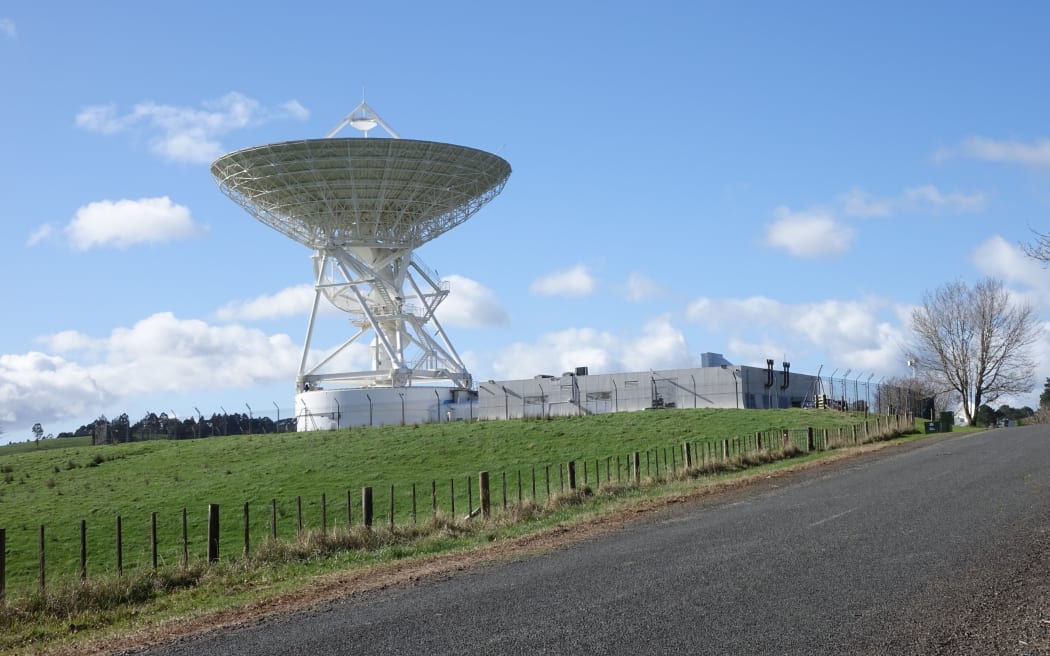The Warkworth Satellite Earth Station helped New Zealand enter the space age in 1971. But a recent bid to close it up has shown this old piece of infrastructure isn't redundant yet.

The 30-metre telescope is in Warkworth. Photo: RNZ
New Zealand's only radio observatory is a familiar site for many travelling north of Auckland.
But when its future was threatened, there were fears its demise would affect some critical scientific data.
At the heart of the issue is scientific funding - not just the lack of it, but the lack of coordination throughout the country.
The Detail looks at the issues New Zealand faces with science funding and asks if it can become more sustainable.
The observatory's satellite dishes are an iconic sight just off State Highway 1 in Warkworth, and have been on postage stamps.
They used to be long-range communications dishes, built to broadcast the 1974 Commonwealth Games in Christchurch, but have since been repurposed by Auckland University of Technology (AUT) into a radio astronomy observatory.
As a radio telescope, it makes observations based on radio waves, rather than optical light like a standard telescope, to learn new things about the universe. It also communicates with spacecraft and collects data for the accuracy of GPS navigation. Some of its functions are almost unique in the Southern Hemisphere.
AUT proposed closing it due to a restructure last year. But concerns were raised about that with the highest levels of government officials, as New Zealand Herald science reporter Jamie Morton discovered.
"There was a large degree of concern, especially from the international geodetic community," Morton says.
"They were basically looking at the loss of this key source of data and thinking 'ok, how is this going to make our measurements less accurate?''
The site has now been saved and, while negotiations are still underway, Southland-based company SpaceOps NZ is due to take it over in June.
"It's a complex issue, universities have overheads and they need to basically be looking at what value those universities are reaping from what they offer," Morton says.
"That can come into conflict with critical science, as we saw here, we saw a critical function provided by this observatory but which was nonetheless, seen as not aligned with AUT's direction or that it just didn't see enough value in the observatory to keep it running.
"It's a pretty common and familiar story throughout New Zealand science to be honest. There's been a few instances in the last few years in particular, where we've seen conflicts of important science versus science that is valued by universities - and in some cases, these lessons have been learned far too late.
"One classic example is the fact that when Covid-19 first broke out, New Zealand essentially didn't have a dedicated infectious disease modelling unit that could give the Government the data it needed, so therefore we saw Professor Shaun Hendy and his colleagues at Te Pūnaha Matatini stand up a team at pretty short notice."
Richard Easther is a professor of physics at the University of Auckland. He specialises in astrophysics and cosmology - everything from the big bang to how galaxies form.
He's concerned about the lack of a funding plan for astronomy in Aotearoa.
"In New Zealand, we've never really had a national strategy for figuring out what it is that we need as a community and so there has been a problem that to do something at scale, you need to do something that's larger than the resources of a single institution.
"Other countries see value in pursuing programmes in fundamental science and so have a national strategy that is hammered out in a conversation between scientists and funders. We've never really had that conversation in New Zealand."
He's calling for a 10-year strategic plan for these kinds of scientific disciplines.
"It's a plan that the field buys into that it essentially pitches to funders ... and then that provides some stability for the development of the assets and the development of the field that then contributes to the overall good of the country through inspiring science.
"If there was a cohesive plan, then AUT would've been able to make better investment decisions about the development of Warkworth and probably wouldn't be in the position that it finds itself now."
Get a more in-depth discussion on the scientific ramifications of closing the station, by listening to the full episode.
You can find out how to listen to and follow The Detail here.
You can also stay up-to-date by liking us on Facebook or following us on Twitter.

Photo:


